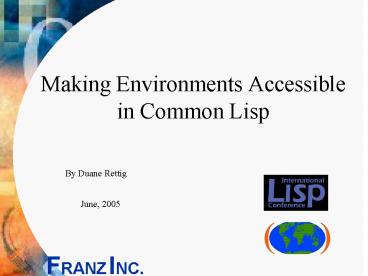Making Environments Accessible in Common Lisp PowerPoint PPT Presentation
1 / 30
Title: Making Environments Accessible in Common Lisp
1
Making Environments Accessible in Common Lisp
By Duane Rettig
June, 2005
2
What is An Environment?
- A set of bindings of names to values
- A context within which to work
- Parameterizations of behaviors
3
Need for Lexical Environments
(defun foo (x y z) (flet ((bar (x) (1
x)) (bas (y) ( x y))) ( x (bar y)
(baz z))))
4
Need for Lexical Environments
(let ((x (foo))) ... (let ((x (bar)))
... ) ... )
5
Need for Dynamic Environments
In lisp (defmacro foo (x) (car ,x)) In
a file (defmacro foo (y) (1 ,y)) (defun bar
(x) (isqrt (foo x)))
6
Typical Implementation of Environments
(let ((x 10)) ... (symbol-macrolet ((x
'foo)) ... (let ((x 20)) ...
here ))) venv lt (... (x . 20)
... (x .sm-marker . foo) ... (x
. 10) ...)
7
Problems with list-style Environments
- Environment has no identity
- Multiple lists are necessary
- Objects not distinguishable as environments
- Accesses can be long for deep contour nesting
- Persistence and contour structure not automatic
8
Desired Representation of Lexical Environment
Elements
Old
x
x
x
Search direction
Hash
New
Contours
Search direction
(lexical 20)
x
(symbol-macro foo)
(lexical 10)
9
Environments Access Design Goals (part 1)
- Compatible with Common Lisp Spec where possible
- Open Source
- Start with CLtL2 definition, moving away only
when necessary - Move the Language forward
- Allow the compiler to be more transparent
- Allow portability of optimizations
10
Environments Access Design Goals (part 2)
- Fast (building, access)
- Portable (on several levels)
- Controllable Persistence
- describes the contour forms
- easy to conceptualize the program structure
- allow multiple entry and annotation for multiple
compiler passes and for debuggers - Consistent for compilation and interpretation
11
Major Departures from Environments in CLtL2
- Entries are bindings, not just names
- Environments have kinds
- Dynamic environment component is added
- Augment-environment can reuse object
- Declarations are done differently
- Define-declaration has different syntax
- Declarations sometimes added after variable
bindings
12
Pictorial View of Environment Objects
e8
lexical namespaces
base
1 3
e7
1 1 1
e6
2 1
e5
1 1
e4
3
e3
2
e2
Dynamic namespaces
1
e1
nil
13
Environment Kinds
- Interpreter (for lisps with interpreter)
- Compilation (compilation-walking in 7.0)
- Evaluation
- Compiler (compilation in 7.0)
- Macros-only
14
Variables Associated with Environments
- interpreter-environment
- compilation-unit-environment
- compile-file-environment in Allegro CL 7.0
- evaluation-environment
15
interpreter-environment Usage
- Only available when an interpreter exists
- Hard to capture - REPL continuously binds
16
compilation-unit-environment Usage
- Created when new compile-file or
with-compilation-unit established - Can be built with either
- sysmake-compilation-unit-environment or
- sysmake-compile-file-environment (deprecated)
17
evaluation-environment Usage
- Read-only feel - definitions taken from
environment but stored globally
18
Extensions Beyond the Spec
- Compiler environments
- Extra arg to macroexpand/macroexpand-1 for
special operators - Environments extend to compilation-unit
19
To Do
- Split define-declaration to allow redefinitions
and development - Add expression-information and expression
argument to augment-environment - Encourage CL vendors to make use of this module
- Accept suggestions
20
Levels of Portability/Porting
- Level 0
- Level 1
- Level 2
- Level 3
- Level 4
21
Levels of Portability/Porting
- Level 0
- Implementation has its own proprietary (open or
not) representation - Level 1
- Level 2
- Level 3
- Level 4
22
Levels of Portability/Porting
- Level 0 Proprietary
- Level 1
- Compilation and operation of the basic
functionality - Level 2
- Level 3
- Level 4
23
Levels of Portability/Porting
- Level 0 Proprietary
- Level 1 Basic
- Level 2
- Current environment emulated at the Environments
Access interface level - Level 3
- Level 4
24
Levels of Portability/Porting
- Level 0 Proprietary
- Level 1 Basic
- Level 2 Emulation
- Level 3
- Environments Access holds the information,
Proprietary interface queries it - Level 4
25
Levels of Portability/Porting
- Level 0 Proprietary
- Level 1 Basic
- Level 2 Emulation
- Level 3 Transitional
- Level 4
- Environments Access fully integrated into
compiler, optionally interpreter - proprietary representation unused or deprecated
26
Levels of Portability/Porting
- Level 0 Proprietary
- Level 1 Basic
- Level 2 Emulation
- Level 3 Transitional
- Level 4 Full
27
Current Levels of Support
28
Current Links
- http//franz.com/support/documentation/7.0/doc/env
ironments.htm - (http//www.lispwire.com/entry-proganal-envaccess-
des)
29
Look at the Implementation (switch to Linux)
- Bring up lisps and demonstrate Environment
building/access - Look at source code for major functions
30
Thank You.

